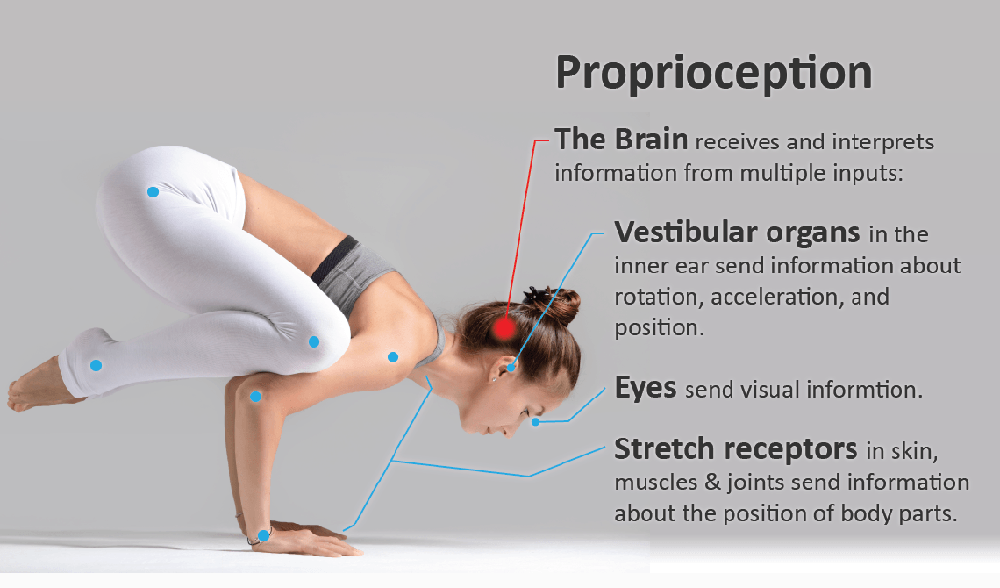Balance is a complex thing in life, but in the body it takes on a whole different meaning. Internally, we have to balance our heart rate, blood pressure, cholesterol, breathing, and digestion. The most critical thing to balance our body functionally is something most people don’t even sense. It’s called Proprioception.
Proprioception is our body’s innate ability to know where it is in space. Meaning, that our body can sense its own positioning. Seems simple right? It is, until our body experiences trauma, strain, or, forbid, a debilitating event such as a stroke or surgery.

Our body’s 6th Sense is much more complex in how it operates. Ask yourself a question: How do you know your foot hit the ground when you walk? Now take it further. How do you know you landed in a stable position which will allow you to absorb the impact, assess the change of ground surface under your foot, and know its safe to load that leg and take your next step? Not so easy is it?

Proprioception works based on our nervous system being able to instantaneously uptake and interpret information and fire a signal back to your muscles with how to respond. Think of how quickly you can walk, run, jump, or climb. Your body has to respond even quicker to create the right response to the ever-changing conditions around you. This is what makes proprioception truly our body’s 6th sense.
But proprioception isn’t just about signals coming from your feet up. Its also about total body position. How do we know that we are slouching at our desk? What about sensing where your arm is when you’re reaching to get the plate out of the upper cabinet?
Our 6th sense has so many far-reaching implications that we cannot function properly without it. Where we see it be the most integral, though, is in our balance. We walk fast, slow, sideways, backwards, and every way in between. But none of that can occur without proprioception.
Now that we know why it’s so important, lets look at what affects proprioception. Orthopedic injuries such as sprains, strains, tears, and broken bones can negatively affect this sense. By changing the length tension relationship of different muscles, it creates an opening for muscles to lag in their ability to sustain and create a contraction to stabilize. Ligaments which have been over stretched cannot provide the natural input back to the brain to then engage stabilizing muscles when the joint moves outside of it normal pattern.

Proprioception is also affected by the combined input of our vestibular system, stretch receptors within the muscles, and our nerves running between our thighs, calves, and ankles/feet. This combined input creates movement strategies to overcome a disturbance in our balance.
Ankle-Knee-Hip Strategy is the way in which our lower body coordinates functional movement of what muscles contract at what time. The old saying “Timing is everything” certainly applies to the way in which our muscles work together to create motion. If your thigh muscles (quadriceps and hamstrings) fire too early it could lead to our toes dragging across the ground and tripping.
Whether you are 1 year old, 21 years old, or 91 years old, proprioception can make or break our ability to move and function. High level athletes need it to stabilize their movement so they can wow us with their athletic prowess. But all of us need it to make sure we don’t end up falling over ourselves

Want to get your proprioception “balanced”….you have to start with finding out why its not working properly. That’s where we come in. A full head to toe assessment to determine the proper treatment path is the first step. From there, progression of balance related exercises to increase stability will help restore your function and confidence.
For more information or to speak with a therapist about the next step to rebalance your body, call (203) 389-4593. Tap into your 6th sense today!
 Kyle Branday, MSPT, is a Physical Therapist and Partner working in the Woodbridge, CT office at 1 Bradley Rd, Suite 801. A graduate of Quinnipiac University in Hamden, CT, Kyle specializes in the treatment of orthopedic and neurological injuries and dysfunction. With over 13 years of experience working with patients from infants and kids to geriatrics and professional athletes, Kyle’s approach to treatment is to maximize a person’s physical potential through functional evaluation and find the root cause of their dysfunction. He can be reached directly at (203) 389-4593 or visit www.amitypt.com/appointments/ to schedule your evaluation.
Kyle Branday, MSPT, is a Physical Therapist and Partner working in the Woodbridge, CT office at 1 Bradley Rd, Suite 801. A graduate of Quinnipiac University in Hamden, CT, Kyle specializes in the treatment of orthopedic and neurological injuries and dysfunction. With over 13 years of experience working with patients from infants and kids to geriatrics and professional athletes, Kyle’s approach to treatment is to maximize a person’s physical potential through functional evaluation and find the root cause of their dysfunction. He can be reached directly at (203) 389-4593 or visit www.amitypt.com/appointments/ to schedule your evaluation.
Tags:
- 6th Sense
- Amity PT
- Balance
- Branford
- Fitness
- Gait
- Hamden
- Milford
- Movement
- New Haven
- Performance
- physical therapy
- Physiotherapy
- Proprioception
- PT
- Sixth Sense
- Stability
- Stabilization
- Wellness
- Woodbridge


